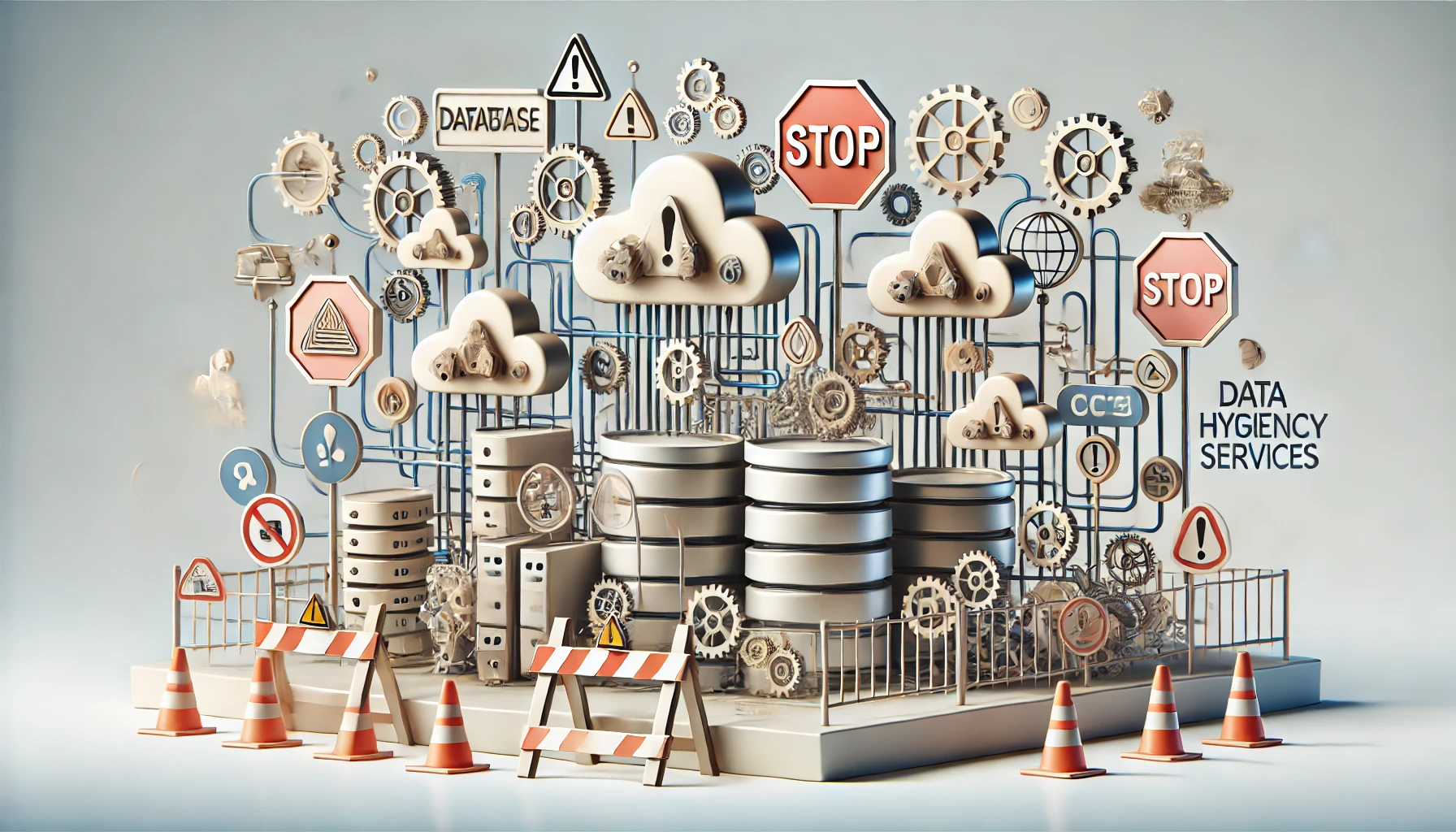You may not realize the intricate web of challenges in implementing data hygiene services. From safeguarding data privacy to tackling integration hurdles, the landscape is rife with complexities that demand attention. As you navigate these top 10 challenges, each one poses unique obstacles that require careful consideration and strategic planning to overcome effectively. Stay tuned to uncover actionable insights on how to address these hurdles and emerge successful in your data hygiene endeavors.
Data Privacy
Data privacy is a critical aspect of implementing data hygiene services. Ensuring that personal and sensitive information is safeguarded is paramount in today’s digital landscape. One key method to protect data privacy is through data encryption. By encoding data, it becomes unreadable to unauthorized users, adding an extra layer of security. This is especially crucial when handling customer information or confidential data within data hygiene processes.
Consent management is another vital aspect of data privacy. Obtaining explicit consent from individuals before collecting or processing their data is essential to maintain transparency and trust. Effective consent management practices involve clearly communicating how data will be used, giving individuals control over their information, and seeking permission for specific data processing activities. By incorporating robust consent management mechanisms into data hygiene services, organizations can ensure compliance with data privacy regulations and build stronger relationships with their customers.
Data Accuracy
Ensuring the accuracy of information within your databases is a fundamental component of successful data hygiene services. Inaccurate data can lead to costly mistakes and hinder effective decision-making. To address data accuracy challenges, consider the following:
- Data Validation: Implement rigorous validation processes to ensure that the data entered into your systems meets predefined criteria and standards.
- Data Cleansing: Regularly clean your databases by removing duplicate, incomplete, or outdated information to maintain data accuracy.
- Automated Checks: Utilize automated tools to perform real-time data validation checks and identify inconsistencies or errors promptly.
- Data Quality Monitoring: Establish ongoing monitoring mechanisms to track data accuracy metrics and address any deviations proactively.
Integration Issues
When addressing integration issues in data hygiene services, you must consider the compatibility of your data systems. Ensuring seamless communication between different platforms is crucial for accurate data management. Workflow disruptions can arise if systems fail to integrate effectively, impacting the overall efficiency of your data hygiene processes.
Data System Compatibility
As organizations aim to enhance their data hygiene practices, one crucial hurdle they often face is the issue of data system compatibility, particularly when it comes to integration challenges. Ensuring seamless integration between different data systems is essential for effective data hygiene services. Here are some key points to consider for addressing data system compatibility issues:
- System Integration: Integrating data hygiene processes with existing systems can be complex and require thorough planning to ensure smooth operation.
- Data Migration: When implementing data hygiene services, the migration of data from legacy systems to new platforms can pose compatibility challenges that need to be carefully managed.
- Interoperability: Ensuring that different data systems can communicate effectively and share information is crucial for maintaining data integrity during the hygiene process.
- API Compatibility: Compatibility of application programming interfaces (APIs) across systems is vital for seamless data exchange and automation, which are integral parts of efficient data hygiene practices.
Workflow Disruptions
Amidst the endeavor to implement data hygiene services, one significant stumbling block that organizations encounter is the disruption of workflows due to integration issues. When implementing data hygiene services, integrating new systems or software can lead to workflow disruptions, impacting productivity and efficiency. Employee resistance to change can exacerbate these disruptions, as individuals may struggle to adapt to new processes or technologies. To mitigate workflow disruptions, organizations must prioritize workflow optimization by thoroughly assessing current processes and identifying potential areas for improvement. Seamless integration of data hygiene services into existing workflows is crucial to minimize disruptions and ensure a smooth transition. Providing adequate training and support to employees can help alleviate resistance and facilitate the adoption of new practices. By addressing integration issues proactively and emphasizing workflow optimization, organizations can navigate through these challenges and successfully implement data hygiene services while maintaining operational efficiency.
Cost Concerns
When considering the challenges of implementing data hygiene services, it is crucial to address the cost concerns that may arise. Budget limitations often play a significant role in decision-making processes regarding data hygiene solutions. Evaluating different pricing structure options can help organizations find a balance between cost-effectiveness and quality service.
Budget Limitations
Navigating the landscape of implementing data hygiene services can present numerous challenges, with one of the most prominent hurdles being budget limitations. Financial constraints and budget constraints often force businesses to make tough decisions when it comes to investing in data hygiene services. Here are some key aspects to consider when facing budget limitations:
- Prioritization: Evaluate which data hygiene services are critical for your organization’s needs to allocate budget effectively.
- Cost-Benefit Analysis: Conduct a thorough cost-benefit analysis to determine the return on investment for implementing data hygiene services.
- Negotiation Skills: Enhance negotiation skills to secure better deals with data hygiene service providers, potentially reducing costs.
- In-House Solutions: Explore the possibility of utilizing in-house resources or tools to handle certain aspects of data hygiene to reduce external service costs.
Pricing Structure Options
Considering the various challenges associated with implementing data hygiene services, the pricing structure options play a crucial role in addressing cost concerns. When evaluating pricing structures for data hygiene services, service customization and competitive analysis are key factors to consider. Service customization allows businesses to tailor the data hygiene services to their specific needs, ensuring that they are paying for the exact services required without any unnecessary extras. This can help in optimizing costs and preventing overspending on services that may not be essential for the business.
Conducting a competitive analysis is also essential when exploring pricing structure options for data hygiene services. By comparing pricing models and packages offered by different service providers in the market, businesses can make informed decisions on which provider offers the best value for their budget. This analysis can help in identifying cost-effective solutions without compromising on the quality of the data hygiene services needed to maintain accurate and up-to-date databases. By carefully considering service customization and conducting a thorough competitive analysis, businesses can navigate the pricing structure options effectively to address cost concerns related to implementing data hygiene services.
Scalability Challenges
As organizations strive to implement data hygiene services, one of the key hurdles they face is the challenge of scalability. Ensuring that the services can handle increasing volumes of data and adapt to evolving needs is crucial for long-term success. Here are some key aspects to consider:
- Scalability Solutions: Look for data hygiene services that offer scalability solutions such as cloud-based options or flexible pricing structures that can accommodate your organization’s growth.
- Technology Advancements: Keep an eye out for providers that leverage the latest technology advancements in data processing and storage to ensure scalability without compromising efficiency.
- Data Segmentation: Opt for services that allow for effective data segmentation, enabling you to manage and clean specific data sets separately to improve scalability.
- Customization Options: Choose providers that offer customization options to tailor the data hygiene services to your organization’s unique scalability requirements and data processing workflows.
Skilled Professional Shortage
Given the challenges organizations face in scaling their data hygiene services, another significant obstacle is the shortage of skilled professionals in this field. The training requirements for data hygiene services are specialized, necessitating a deep understanding of data management, quality assurance processes, and compliance regulations. However, finding individuals with these skills can be challenging, leading to a shortage of qualified professionals.
Skill development is crucial in addressing this shortage. Organizations must invest in training programs to upskill existing employees or attract new talent to the field. These programs should focus on enhancing data processing capabilities, improving data analysis techniques, and staying updated on the latest data hygiene technologies and best practices.
To overcome the skilled professional shortage in data hygiene services, a strategic approach to skill development is essential. By prioritizing training requirements and investing in skill development initiatives, organizations can build a strong team of professionals capable of effectively managing and maintaining data hygiene processes.
Time Consumption
When it comes to implementing data hygiene services, time consumption is a significant factor to consider. You must carefully allocate resources to ensure that the process is efficient and effective. Additionally, addressing training needs is crucial to minimize the time spent on resolving issues and optimizing data quality.
Resource Allocation
Implementing data hygiene services can be a significant endeavor, especially when considering resource allocation, particularly the time consumption involved. When it comes to allocating resources for data hygiene services, you need to carefully consider the following:
- Team Collaboration: Coordinating efforts among team members can be time-consuming, as it requires effective communication and alignment of goals.
- Tool Selection: Choosing the right tools for data cleansing and maintenance is crucial, but it can take time to research and evaluate the best options available.
- Prioritization: Determining which data sets need to be cleaned first and how resources should be distributed across different tasks can be a time-intensive process.
- Monitoring and Maintenance: Ongoing monitoring and maintenance activities to ensure data cleanliness require a consistent allocation of time and resources to sustain the integrity of the database.
Balancing these aspects of resource allocation efficiently is key to successfully implementing data hygiene services within your organization.
Training Needs
To effectively address the time consumption associated with training needs in implementing data hygiene services, organizations must prioritize structured onboarding processes and continuous education initiatives. Skill development plays a crucial role in ensuring that employees are equipped with the necessary knowledge and expertise to effectively carry out data hygiene tasks. By investing in training programs that focus on skill enhancement, organizations can streamline processes and improve overall efficiency.
Team collaboration is another key aspect when it comes to training needs in data hygiene services. Encouraging collaboration among team members through group training sessions or workshops can foster a sense of unity and shared responsibility towards maintaining data accuracy and cleanliness. This collaborative approach not only enhances individual skills but also promotes a culture of teamwork within the organization.
Compliance Hurdles
Navigating the landscape of data hygiene services can be a complex endeavor, particularly when it comes to compliance hurdles. When implementing data hygiene services, you must address several compliance challenges:
- Legal Requirements: Ensuring that your data hygiene processes comply with all relevant laws and regulations is essential. Failure to adhere to legal requirements can result in severe consequences for your organization.
- Data Protection: Safeguarding sensitive information is paramount. Implementing data hygiene services while maintaining high standards of data protection requires careful planning and execution.
- Privacy Regulations: Adhering to privacy regulations such as GDPR or CCPA adds another layer of complexity. Understanding these regulations and integrating them into your data hygiene practices is crucial.
- Third-Party Compliance: If you are using third-party vendors for data hygiene services, ensuring that they also comply with all legal and data protection requirements is vital. Conducting thorough due diligence on these vendors is necessary to avoid compliance risks.
Data Security Risks
Addressing the challenges of compliance hurdles in data hygiene services leads us to confront the looming threat of data security risks. To mitigate these risks, robust cybersecurity measures must be implemented. Data breach prevention is a critical aspect of maintaining the integrity of data hygiene services.
Cybersecurity measures play a vital role in safeguarding sensitive information from unauthorized access, ensuring compliance with data protection regulations, and maintaining customer trust. Encryption, access controls, and regular security audits are essential components of a comprehensive cybersecurity strategy. By proactively identifying vulnerabilities and implementing appropriate security protocols, organizations can reduce the likelihood of data breaches.
Data breach prevention requires a proactive approach that involves continuous monitoring, threat detection, and incident response planning. Regular security assessments and employee training on data security best practices are crucial for creating a culture of vigilance against potential threats. By staying informed about emerging cybersecurity trends and continuously updating security protocols, organizations can effectively mitigate data security risks and uphold the confidentiality and integrity of their data.
Change Management Difficulty
Experiencing challenges in implementing data hygiene services, you are now faced with navigating the complexities of change management difficulty. This phase requires a strategic approach to ensure a smooth transition and successful adoption of new processes. Here are some key aspects to consider:
- Employee Resistance: Acknowledge that resistance to change is natural. Address concerns, provide training, and involve employees in the process to increase buy-in.
- Communication Strategies: Effective communication is vital. Keep employees informed about the changes, explain the reasons behind them, and highlight the benefits to motivate acceptance.
- Leadership Support: Strong leadership is crucial. Leaders must champion the changes, set a positive example, and be available to address any issues or uncertainties.
- Feedback Mechanisms: Establish feedback channels for employees to voice their opinions and concerns. Act on feedback promptly to show that their input is valued and considered in decision-making processes.
Navigating change management difficulties requires proactive planning, open communication, and a supportive environment to ensure successful implementation of data hygiene services.
Frequently Asked Questions
How Can Data Hygiene Services Improve Customer Satisfaction?
To enhance customer satisfaction, data hygiene services improve accuracy by cleansing and organizing data. This process boosts insights into customer preferences, enabling tailored marketing strategies. By maintaining clean data, you can personalize interactions and deliver more relevant experiences.
What Are the Long-Term Benefits of Investing in Data Hygiene?
Investing in data hygiene brings astonishing long-term benefits. Improved accuracy enhances decision-making, leading to tailored customer experiences. Cost savings arise from reduced errors and streamlined operations. The ripple effect creates a solid foundation for sustainable growth.
Can Data Hygiene Services Help in Reducing Marketing Expenses?
Yes, data hygiene services can significantly reduce marketing expenses by ensuring accurate customer information, targeting the right audience, and improving campaign effectiveness. Proper data management translates to cost savings and enhanced marketing results.
Are There Any Industry-Specific Challenges in Data Hygiene Implementation?
Thinking about industry-specific challenges in data hygiene implementation? Well, healthcare regulations and financial compliance can throw a wrench in the works. Navigating these hurdles requires attention to detail and a thorough understanding of the data landscape.
How Do Data Hygiene Services Impact Overall Business Efficiency?
Data accuracy from data hygiene services enhances operational efficiency by streamlining processes, reducing errors, and enabling informed decision-making. Maintaining clean data ensures smoother operations, eliminates redundancies, and boosts overall business productivity.




